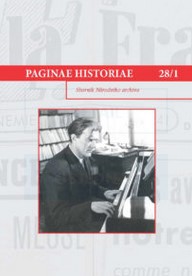PLUKOVNÍK A RYTMISTR ANEB NENÍ ISOLANO JAKO ISOLANO
A COLONEL AND A CAPTAIN, OR ISOLANO IS NOT THE SAME AS ISOLANO
Author(s): Marek StarýSubject(s): Military history, Social history, 17th Century
Published by: Národní archiv
Keywords: General Johann Ludwig Hektor Count Isolano; 1635-1640; different fates of two Isolano brothers; Jan Ludvík; Jan Křtitel;
Summary/Abstract: One of the prominent Imperial commanders that settled down in Bohemia during the Thirty Years War and gained allodial land estates was General Johann Ludwig Hektor Count Isolano. He first became a vassal to the Duke of Frýdlant Albrecht of Wallenstein when he bought estates Zásadka and Chocnějovice in the years 1627–1628, after Walenstein’s end he received in 1636 as a gift from Emperor Ferdinand II a formerly chamber estate Český Dub. After General’s death, the fates of these two land estates split again. The estate of Český Dub was inherited by his daughters and went on to Viennese Augustinian convent of Saint James where the younger daughter lived as a nun (not as an abbes as can be found in the literature). Zásadka and Chocnějovice came to the hands of the titular bishop of Tripolus Paul of Aldringen who later ceded them to his sister Anna and to her husband Hieronymus of Clary who founded the House of Clary-Aldringen. The historiography has not given yet the answer to why Český Dub and Zásad-ka with Chocnějovice were split after General’s death. At the same time, various and not always corresponding data on the general Isolano life can be found, especially as for his date of death that varies between 1640–1641. A research based on primary sources brought a surprising finding – there were actually two Imperial officers of the same name and from the same family that became involved in the history of 17th century Bohemia. Apart from Count Johann Ludwig Hector, there was also his nephew Johann Baptist who, based on the General’s last will recorded in the land register, inherited Zásadka and Chocnějovice in 1640. However, he died a year later and in his testament, Bishop Paul Aldringen was appointed to be the main inheritor while, at the same, burdening the heritage with a number of obligations. The validity of his last will was questioned by his cousins, General’s daughters, who were successful at the trial at the Land Court, yet, the verdict was subject to a revision in 1651 by the decision of the Emperor, so that both estates stayed in the hands of Clary family. The double personality of Johann Isolano is attested also by sources pertaining to gaining the inhabitant right in Bohemia (Inkolat) in the period after 1618. Johann Ludwig and Johann Baptist left parchment waivers supplemented with their respective seals (from 1635 and 1640) as well as subsequent declaration of land allegiance recorded in the land register. In the form of the concept and a copy, there have been preserved also Imperial decrees that opened the way for them among the Bohemian nobility. These documents can also demonstrate a certain instability of the usual practise newly reformed by the Renewed Land Constitution (before the battle at the White Mountain, the inhabitant right had a strictly “land” character and was be-stowed solely by the Land Diet). While General Johann Ludwig was indeed adopted by the Emperor Ferdinand III as an inhabitant of the Kingdom („zu einem Innwohner und Landmann“), his nephew was given only a consent to purchase and acquire estates in the land. A broad-based survey to the sources dating to 1630s shows that both types were used concurrently in the practise of the time. Despite obvious differences in the content, they both led to the same goal, the addressees, after meeting other requirements, became full members of the estates’ community in the various crownlands, having acquired the inhabitant right in its full scope.
Journal: Paginae Historiae
- Issue Year: 28/2020
- Issue No: 1
- Page Range: 40-62
- Page Count: 23
- Language: Czech

